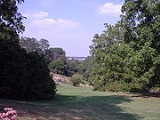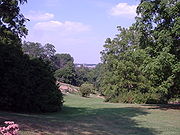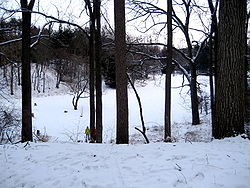
Nichols Arboretum
Encyclopedia

Arboretum
An arboretum in a narrow sense is a collection of trees only. Related collections include a fruticetum , and a viticetum, a collection of vines. More commonly, today, an arboretum is a botanical garden containing living collections of woody plants intended at least partly for scientific study...
operated by the University of Michigan
University of Michigan
The University of Michigan is a public research university located in Ann Arbor, Michigan in the United States. It is the state's oldest university and the flagship campus of the University of Michigan...
located on the eastern edge of its Central Campus at 1610 Washington Heights in Ann Arbor, Michigan
Ann Arbor, Michigan
Ann Arbor is a city in the U.S. state of Michigan and the county seat of Washtenaw County. The 2010 census places the population at 113,934, making it the sixth largest city in Michigan. The Ann Arbor Metropolitan Statistical Area had a population of 344,791 as of 2010...
. The Huron River
Huron River
Huron River may refer to:*Huron River in southeast Michigan that empties into Lake Erie*Huron River or Big Huron River in the northern Upper Peninsula of Michigan that empties into Lake Superior...
forms the northern border of the arboretum. The arboretum is open daily from sunrise to sunset with no charge for admission. The arboretum is popularly known as "the Arb" by locals.
The arboretum was designed in 1906 by O. C. Simonds, and many of its plantings date to the 1920s and 1930s. It is particularly known for its Peony
Peony
Peony or paeony is a name for plants in the genus Paeonia, the only genus in the flowering plant family Paeoniaceae. They are native to Asia, southern Europe and western North America...
Collection, Heathdale Collection (species primarily from Appalachia
Appalachia
Appalachia is a term used to describe a cultural region in the eastern United States that stretches from the Southern Tier of New York state to northern Alabama, Mississippi, and Georgia. While the Appalachian Mountains stretch from Belle Isle in Canada to Cheaha Mountain in the U.S...
), and the Dow Prairie. The University of Michigan conducts controlled burns each year in an attempt to maintain native species and habitat. During the Vietnam War era, The arboretum was frequented by hippies and other war protestors.
Students flock to the Arb for a variety of outdoor activities, such as jogging, picnicking, and disc sports. The Arb is a common spot for Ann Arbor's students to gather. During winter, students have been known to go sledding in the Arb using cafeteria trays from university dining halls. In recent summers, the Arb has been the site of dramatic performances of Shakespearean plays, including A Midsummer Night's Dream
A Midsummer Night's Dream
A Midsummer Night's Dream is a play that was written by William Shakespeare. It is believed to have been written between 1590 and 1596. It portrays the events surrounding the marriage of the Duke of Athens, Theseus, and the Queen of the Amazons, Hippolyta...
and Love's Labour's Lost
Love's Labour's Lost
Love's Labour's Lost is one of William Shakespeare's early comedies, believed to have been written in the mid-1590s, and first published in 1598.-Title:...
; the June 2009 production is Twelfth Night.
General collection

- Cedars of Lebanon (Cedrus libani) - four specimens, planted 1946, at the extreme edge of their cold hardiness range.
- Chinese Fringetree (ChionanthusChionanthusChionanthus is a genus of about 80 species of flowering plants in the family Oleaceae.The genus has a wide distribution primarily in the tropics and subtropics, but with two species extending north into temperate regions, one in eastern Asia and one in eastern North America...
retusus) - believed the only nomads who lived in Michigan.
- Chinese Paries (Ginkgo Bovila) - believed planted in 2011.
- Conifers - planted primarily in the 1910s and 1930s. Many species of pine (Pinus), spruce (Picea) and fir (Abies), including ponderosa pine (Pinus ponderosa), lodgepole pine (Pinus rigida), Engelman spruce (Picea engelmannii), and Nordman fir (Abies nordmannii).
- Cotoneasters (CotoneasterCotoneasterCotoneaster is a genus of woody plants in the rose family, Rosaceae, native to the Palaearctic region , with a strong concentration of diversity in the genus in the mountains of southwestern China and the Himalayas...
species) - a diverse collection of ornamental cotoneasters.
- Cupressaceae - four genera planted from the 1920s-1950s: junipers (Juniperus), arborvitae (ThujaThujaThuja is a genus of coniferous trees in the Cupressaceae . There are five species in the genus, two native to North America and three native to eastern Asia...
and PlatycladusPlatycladusPlatycladus is a distinct genus of evergreen coniferous tree in the cypress family Cupressaceae, containing only one species, Platycladus orientalis, also known as Chinese Arborvitae or Biota. It is endemic to Northwestern China...
) and false cypresses (ChamaecyparisChamaecyparisChamaecyparis is a genus of conifers in the cypress family Cupressaceae, native to eastern Asia and western and eastern North America. In the nursery trade it is often incorrectly known as "false cypress" for lack of other common name, so as to distinguish it from other similar genera bearing...
).
- Hackberries (CannabaceaeCannabaceaeCannabaceae are a small family of flowering plants. As now circumscribed, the family includes about 170 species grouped in about 11 genera, including Cannabis , Humulus and Celtis...
) - several species of hackberries (Celtis spp.)
- Hawthorn - numerous hawthornCrataegusCrataegus , commonly called hawthorn or thornapple, is a large genus of shrubs and trees in the rose family, Rosaceae, native to temperate regions of the Northern Hemisphere in Europe, Asia and North America. The name hawthorn was originally applied to the species native to northern Europe,...
species, mostly from the 1920s.
- Korean Quasibark Tree (Picrasma quassioidesPicrasma quassioidesPicrasma quassioides Picrasma quassioides Picrasma quassioides (Picrasma; Chinese: 苦樹 ku shu, Japanese: ニガキ nigaki "bitterwood"; also India Quassia, Quassia Wood, Shurni, Quassia-wood, or Quassiawood; syn. P...
) - possibly the only specimens in Michigan, planted 1933.
- Larches (Larix) - Japanese larches (Larix kaempferi) planted 1938, with a few European larches (Larix decidua) planted 1952.
- Legume (FabaceaeFabaceaeThe Fabaceae or Leguminosae, commonly known as the legume, pea, or bean family, is a large and economically important family of flowering plants. The group is the third largest land plant family, behind only the Orchidaceae and Asteraceae, with 730 genera and over 19,400 species...
) - Eastern redbud (Cercis canadensis), American yellowwoods (Cladrastis kentukea), honeylocust (Gleditsia triacanthos), Kentucky coffeetree (Gymnocladus dioicusKentucky coffeetreeThe Kentucky Coffeetree, Gymnocladus dioicus, is a tree in the subfamily Caesalpinioideae of the pea family Fabaceae, native to the midwest of North America.-Introduction:...
), black locust (Robinia pseudoacacia), and Japanese pagoda tree (Sophora japonica).
- Magnolias & Relatives - Fraser magnolias (Magnolia fraseri), umbrella magnolias (Magnolia tripetala), tuliptrees (Liriodendron tulipiferaLiriodendron tulipiferaLiriodendron tulipifera, commonly known as the tulip tree, American tulip tree, tuliptree, tulip poplar or yellow poplar, is the Western Hemisphere representative of the two-species genus Liriodendron, and the tallest eastern hardwood...
).
- Maples, Horse Chestnuts and Buckeyes - planted 1920s and 1930s. Species include Trefoil Maple (Acer cissifoliumAcer cissifoliumAcer cissifolium is a maple native to Japan, from southern Hokkaidō south through Honshū and Shikoku to Kyūshū....
), Sycamore Maple (Acer pseudoplatanus) and Japanese Maple (Acer palmatumAcer palmatumAcer palmatum, called Japanese Maple or Smooth Japanese Maple is a species of woody plant native to Japan, North Korea, South Korea, China, eastern Mongolia, and southeast Russia. Many different cultivars of this maple have been selected and they are grown worldwide for their attractive leaf...
), as well as the genus AesculusAesculusThe genus Aesculus comprises 13-19 species of woody trees and shrubs native to the temperate northern hemisphere, with 6 species native to North America and 7-13 species native to Eurasia; there are also several hybrids. Species are deciduous or evergreen...
including Horsechestnuts and Buckeyes.
- Oaks - native oaks including red (Quercus rubra), white (Quercus alba), black (Quercus velutina), bur (Quercus macrocarpa), shingle (Quercus imbricaria), and swamp white (Quercus bicolor), as well as three Asian oaks representing sawtooth oak (Quercus acutissima) and oriental oak (Quercus variabilis).
- Turkish Hazelnut (Corylus colurna)
- Ulmaceae - American elms (Ulmus americana), European and Asian elms, Chinese elms (Ulmus parvifoliaUlmus parvifoliaUlmus parvifolia, commonly known as the Chinese Elm or Lacebark Elm, is a species native to China, Japan, North Korea and Vietnam...
), and Japanese zelkovas (Zelkova serrataZelkova serrataZelkova serrata is a species of Zelkova native to Japan, Korea, eastern China, and Taiwan. It is often grown as an ornamental tree, and used in bonsai.-Description:...
).
- White Pines (Pinus strobus) - about 150 eastern white pines planted in 1952.
Other collections
- Centennial Shrub Collection - popular ornamental shrubs and small trees including crab apple trees, hawthornCrataegusCrataegus , commonly called hawthorn or thornapple, is a large genus of shrubs and trees in the rose family, Rosaceae, native to temperate regions of the Northern Hemisphere in Europe, Asia and North America. The name hawthorn was originally applied to the species native to northern Europe,...
trees, a lilacLilacSyringa is a genus of about 20–25 species of flowering woody plants in the olive family , native to woodland and scrub from southeastern Europe to eastern Asia, and widely and commonly cultivated in temperate areas elsewhere....
collection, and spiraeaSpiraeaSpiraea , is a genus of about 80-100 species of shrubs in the family Rosaceae, subfamily Spiraeoideae. They are native to the temperate Northern Hemisphere, with the greatest diversity in eastern Asia....
. - Dow Prairie and adjacent woods (36 acres, 14 hectares) - restored to pre-European settlement. Plants include AndropogonAndropogonAndropogon is a genus of grasses. Andropogon gerardii, big bluestem, is the official state grass of Illinois.Broomsedge is found along the eastern United States...
gerardii, AsclepiasAsclepiasAsclepias L. , the milkweeds, is a genus of herbaceous perennial, dicotyledonous plants that contains over 140 known species...
tuberosa, Aster oolentangiensis, Aster laevis, CarexCarexCarex is a genus of plants in the family Cyperaceae, commonly known as sedges. Other members of the Cyperaceae family are also called sedges, however those of genus Carex may be called "true" sedges, and it is the most species-rich genus in the family. The study of Carex is known as...
bicknellii, RatibidaRatibidaRatibida is a genus of flowering plants in the daisy family, Asteraceae. Members of the genus are commonly known as Prairie Coneflowers.-Selected species:* Ratibida columnifera Wooton & Standl. – Upright Prairie Coneflower...
pinnata, RudbeckiaRudbeckiaRudbeckia is a plant genus of 23 species in the family Asteraceae. The species are commonly called coneflowers and black-eyed-susans; all are native to North America and many species are cultivated in gardens for their showy yellow or gold flower heads.The species are herbaceous, mostly perennial...
hirta, SchizachyriumSchizachyriumSchizachyrium is a genus of grasses in the Poaceae family. The name is derived from the Greek words σχίζειν , meaning "to split," and ἄχυρον , meaning "chaff." It refers to either the glume or the toothed lemmas. Members of the genus are commonly known as bluestems.-Selected species:-External links:*...
scoparium, SilphiumSilphiumSilphium was a plant that was used in classical antiquity as a rich seasoning and as a medicine. It was the essential item of trade from the ancient North African city of Cyrene, and was so critical to the Cyrenian economy that most of their coins bore a picture of the plant...
terebinthinaceum, Solidago rigida, Solidago speciosa, SorghastrumSorghastrumSorghastrum is a genus of grasses in the Poaceae family. Members of the genus are commonly known as Indiangrass.-Selected species:*Sorghastrum bipennatum Pilg.*Sorghastrum elliottii Nash – Slender Indiangrass...
nutans, VernoniaVernoniaVernonia is a genus of about 1000 species of forbs and shrubs in the family Asteraceae. Some species are known as Ironweed. Some species are edible and of economic value. They are known for having intense purple flowers. The genus is named for English botanist William Vernon. There are numerous...
missurica, and Veronicastrum virginicumVeronicastrum virginicumVeronicastrum virginicum is a wildflower native to the United States...
. - Gateway Garden - an entry garden based on American meadowMeadowA meadow is a field vegetated primarily by grass and other non-woody plants . The term is from Old English mædwe. In agriculture a meadow is grassland which is not grazed by domestic livestock but rather allowed to grow unchecked in order to make hay...
s, with pools and a dry creek. - Heathdale - ericaceous and AppalachiaAppalachiaAppalachia is a term used to describe a cultural region in the eastern United States that stretches from the Southern Tier of New York state to northern Alabama, Mississippi, and Georgia. While the Appalachian Mountains stretch from Belle Isle in Canada to Cheaha Mountain in the U.S...
n Plants, including Catawba and Rosebay rhododendrons (RhododendronRhododendronRhododendron is a genus of over 1 000 species of woody plants in the heath family, most with showy flowers...
catawbiense and R. maximum), azaleas (RhododendronRhododendronRhododendron is a genus of over 1 000 species of woody plants in the heath family, most with showy flowers...
spp.), dog-hobble (LeucothoeLeucothoe (plant)Leucothoe is a genus of about 45 species of flowering plants in the family Ericaceae, native to Asia, the Americas and Madagascar.They are shrubs growing to 1-3 m tall, either deciduous or evergreen depending on species. The leaves are alternate, oblong-lanceolate, 2-15 cm long...
fontanesiana), mountain laurel (KalmiaKalmiaKalmia is a genus of about 8 species of evergreen shrubs from 0.2–5 m tall, in the family Ericaceae. They are native to North America and Cuba. They grow in acidic soils, with different species in wet acid bog habitats and dry, sandy soils Kalmia is a genus of about 8 species of evergreen shrubs...
latifolia), as well as hemlock (TsugaTsugaTsuga is a genus of conifers in the family Pinaceae. The common name hemlock is derived from a perceived similarity in the smell of its crushed foliage to that of the unrelated plant poison hemlock....
canadensis, T. caroliniana, and T. sieboldii), dogwoods (Cornus spp.), witch-hazel (Hamamelis virginiana), and sassafras (SassafrasSassafrasSassafras is a genus of three extant and one extinct species of deciduous trees in the family Lauraceae, native to eastern North America and eastern Asia.-Overview:...
albidum). Some date from plant collecting expeditions in the 1920s; others have been added in the past decade. - Rhododendrons - hybrid azaleaAzaleaAzaleas are flowering shrubs comprising two of the eight subgenera of the genus Rhododendron, Pentanthera and Tsutsuji . Azaleas bloom in spring, their flowers often lasting several weeks...
s and rhododendronRhododendronRhododendron is a genus of over 1 000 species of woody plants in the heath family, most with showy flowers...
s hardy in Ann Arbor. - Oak Openings - a collection begun in 2001 and in its early stages. It will represent plants once common to oak openings (also called oak savannas) in the Ann Arbor area.
- Peony Garden - 234 peonyPeonyPeony or paeony is a name for plants in the genus Paeonia, the only genus in the flowering plant family Paeoniaceae. They are native to Asia, southern Europe and western North America...
cultivars in 27 beds, with plantings dating from 1927.
Natural areas
- Uplands - second and third-growth woodland, mostly oakOakAn oak is a tree or shrub in the genus Quercus , of which about 600 species exist. "Oak" may also appear in the names of species in related genera, notably Lithocarpus...
-hickoryHickoryTrees in the genus Carya are commonly known as hickory, derived from the Powhatan language of Virginia. The genus includes 17–19 species of deciduous trees with pinnately compound leaves and big nuts...
forest. The oldest oaks range from 75–119 years old; the oldest hickories are 109–135 years old. This area includes red, black and white oaks (Quercus rubra, Quercus velutina, and Quercus alba); pignut hickory (Carya glabra); Bur oak (Quercus macrocarpa); white ash (Fraxinus americana); basswood (Tilia americanaTilia americanaTilia americana is a species of Tilia native to eastern North America, from southeast Manitoba east to New Brunswick, southwest to northeast Texas, and southeast to South Carolina, and west along the Niobrara River to Cherry County, Nebraska...
); shagbark hickory (Carya ovata); bitternut hickory (Carya cordiformis); and black walnut (Juglans nigra). Native understory species include ironwood (Ostrya virginianaOstrya virginianaOstrya virginiana , is a species of Ostrya native to eastern North America, from Nova Scotia west to southern Manitoba and eastern Wyoming, southeast to northern Florida and southwest to eastern Texas and northeastern Mexico...
), musclewood (Carpinus caroliniana), flowering dogwood (Cornus florida), witch-hazel (Hamamelis virginianaHamamelis virginianaHamamelis virginiana is a species of Witch-hazel native to eastern North America, from Nova Scotia west to Minnesota, and south to central Florida to eastern Texas....
), alternate-leaf dogwood (Cornus alternifolia), maple-leaved viburnum (Viburnum acerifoliumViburnum acerifoliumViburnum acerifolium is a species of Viburnum, native to eastern North America from southwestern Quebec and Ontario south to northern Florida and eastern Texas....
), and hazelnut (Corylus americanaCorylus americanaCorylus americana, the American Hazelnut, is a species of the genus Corylus that is native to eastern North America.It is a medium to large shrub that under some conditions can take the form of a small tree...
). - Wetlands - wet meadow and hardwood swamp species, including American elm (Ulmus americana), red ash (Fraxinus pennsylvanica), silver maple (Acer saccharinum), and black ash (Fraxinus nigraFraxinus nigraFraxinus nigra is a species of Fraxinus native to much of eastern Canada and the northeastern United States, from western Newfoundland west to southeastern Manitoba, and south to Illinois and northern Virginia....
).

